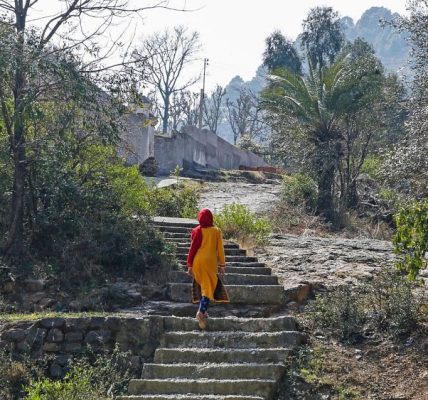
Coffee connoisseurs have long held the belief that adding a little water to the beans before grinding them could make a difference. A new study by researchers at the University of Oregon seems to confirm exactly why.
The research explored how the technique, which started as an attempt to address the often messy coffee-making process, also affected flavor.
“When you grind coffee, it goes everywhere,” said study coauthor Christopher Hendon, an associate professor of computational materials chemistry at the University of Oregon. “Dust comes out of the grinder, it’s like a plume that covers everything. But if you add a little water, it seems to not go everywhere. It’s cleaner. That was the primary reason people did it.”
The mess is caused by static electricity, which is created by friction when the beans are smashed together. This static charge then makes the particles of ground coffee repel each other — like magnets of the same polarity — sending them off in every direction.
Water acts like an insulator, dampening this effect — a process known as the “Ross droplet” technique. “It was first proposed by some enthusiast on a home barista forum,” Hendon said. “The idea has been around for several years, and originally it was borrowed from the materials production industry, like wood pulping.”
However, what started out as a way to reduce mess slowly morphed into a more sophisticated way to obtain a better brew — or at least so people thought. The theory was that by reducing static electricity, water not only kept the ground coffee from flying around or sticking to the insides of the grinder, it also prevented microscopic clumps from forming during brewing.
Why are clumps bad? Because water flows around them, leaving untouched coffee — and therefore flavor — behind. In barista parlance, they decrease extraction yield, or the amount of coffee that ends up in the cup, dissolved in the liquid.
“If you have clumps forming, there’s going to be significant amounts of void space, kind of like when you stack watermelons,” Hendon said. “As a result when you push water through you end up with less surface area touching the water and therefore lower extraction.”
The study, published December 6 in the journal Matter, tested this more subtle, harder to see potential benefit of adding water to the beans: getting rid of flavor-robbing microclumps.

Start with a single drop of water and build up from there, experts say.
Elena Popova/Moment RF/Getty Images
Putting ‘Ross droplet’ to the test
The research team included two volcanologists, who repurposed a tool usually employed to measure electric charges on wildfire and volcanic ash. They weighed coffee before adding water — using a pipette for precision down to the microgram — and then ground it in a professional grinder, one of the fastest on the market and a popular choice in cafes.
“The addition of small amounts of water — ranging from one droplet upwards — passivates, or turns off, the static charge and it does it in a way that the coffee exits the grinder never having been charged,” Hendon said. It’s unclear what exactly the water is doing, but he said it’s perhaps absorbing the charge or changing the temperature inside the grinder, reducing the effects of friction.
“If you add a sufficient amount of water, you can also remove the formation of the clumps,” he added. “You will in principle achieve higher extractions or less waste. That’s exactly what this does, because you’re now providing more available surface area for the same amount of water.”
Without clumps, all of the brewing water comes into contact with the ground beans, reducing the amount of coffee that goes effectively unused and giving a more consistent brew.
The ideal amount of water can change based on parameters such as the type of roast and the coarseness of the grind, so there is no one-size-fits-all rule, but on average, the study found that adding water increases the extraction yield by 10%. Hendon warned that this doesn’t necessarily equate to a tangible difference in flavor, but it does confirm the benefit of the “Ross droplet” technique.
“(Since the study published) I’ve been receiving a lot of emails from people telling me how grateful they are, because from just a cleanliness standpoint, this is a massive, massive upgrade,” Hendon said. “What I would recommend for the home user is to start with a single drop of water and build up from there — there is a substantial amount of nuance in this process.”
There’s also a catch: The water improves cleanliness regardless of your brewing method, but a brewing benefit only occurs with espresso and, to a lesser extent, filter coffee. When using a cafetiere, French press or AeroPress, nothing much changes because, given the coarser grind required with these, “all of the water is already touching all of the coffee,” Hendon said.
The quest for a better brew
Lance Hedrick, a coffee expert and professional barista who wasn’t involved with the study, has tried to replicate the study’s findings and discussed his results in a deep dive on YouTube. He said the work makes a valiant attempt to demystify what is going on when beans are spritzed with water, but for more conclusive evidence, more tests with different grinder models should be performed.
However, based on his own tests, he said he thinks the benefits are plausible.
“I found that the amount of water needed for the purported benefits varied wildly from grinder to grinder,” he added. “So, although I don’t think there is currently a practical catch-all implication from the study to immediately improve coffee brewing at home, I think it is an important addition to the attempts at hand trying to understand the extremely complex process of grinding, which is arguably the most important aspect of brewing a cup.”
François Knopes of the Independent Coffee Lab, a professional coffee roaster and taster who also was not involved with the study, said he routinely sprays his beans before grinding for tasting evaluation and would recommend doing so to anyone in a home setting. However, he thinks doing so elsewhere might be impractical.
“It would be highly time consuming for most professional setups, such as a coffee shop serving hundreds of espresso-based drinks per day,” Knopes said. “To improve and increase extraction, professional baristas are better off looking for improved grinding technologies or ‘de-clumping’ devices, little needles used to whisk the grounds and break the small boulders generated during grinding.”
Hendon agreed. “For the time being, it is a little impractical in the sense that you’d have yet another step,” he said. “But I suspect that there will be technologies that will be developed around this idea that adding water on demand is a very powerful technique.”
Correction: An earlier version of this story misspelled Lance Hedrick’s last name.




